



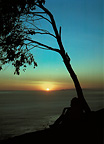







The Friedman Archives Newsletter
February, 2010
In this issue:
Lumodi - A different Breed of Flash Diffuser
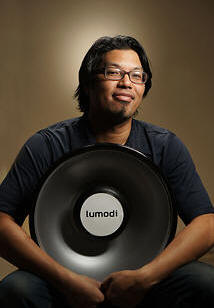
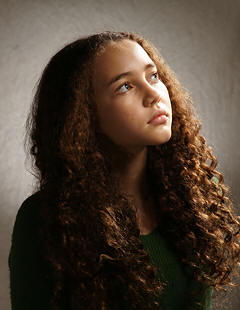 You've heard of umbrellas and softboxes before -
those are classical means
of diffusing light (especially light from an
accessory flash) for very pleasing portraits.
You've heard of umbrellas and softboxes before -
those are classical means
of diffusing light (especially light from an
accessory flash) for very pleasing portraits.
Let me introduce you to a 3rd kind of diffuser: Something called a "Beauty Dish" made by a company called Lumodi. It's light output isn't quite as soft as an umbrella or softbox but definitely not harsh like an undiffused flash. It has its own character, which made for a more dramatic impact for the portraits to the right. Beauty dishes are also lightweight and can be set up in literally two seconds (just stick your accessory flash into the opening in the back and you're all set!). The portrait on the right is that of the Lumodi's president - a talented photographer, industrial designer, and entrepreneur named Brandon Cruz. The Lumodi dishes sell for $69.96 and you can buy them (as well as see LOTS of other great examples of pictures taken with this light) off their website - www.lumodi.com. It's great fun to play with.

How These Portraits Were Made
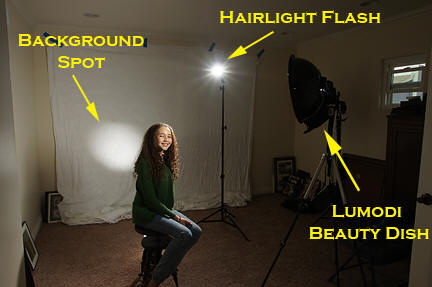 How were the
portraits above taken? Have a look at the wide shot to the
left. A total of 3 wireless flashes were used: One lighting
the face (using the Lumodi beauty dish), one creating the "spot" in
the background (more about that in a minute), and a 3rd just to add
just a touch of accent light to the hair. You can see the
unmodified hairlight flash in the picture, which sits behind the
subject and points toward the back of the head. In truth this
flash is completely optional; it adds such subtle light to the
transition between head and background that most people wouldn't
notice if it were gone. But I personally like the extra touch
that it provides and besides, I had an extra wireless flash handy.
:-)
How were the
portraits above taken? Have a look at the wide shot to the
left. A total of 3 wireless flashes were used: One lighting
the face (using the Lumodi beauty dish), one creating the "spot" in
the background (more about that in a minute), and a 3rd just to add
just a touch of accent light to the hair. You can see the
unmodified hairlight flash in the picture, which sits behind the
subject and points toward the back of the head. In truth this
flash is completely optional; it adds such subtle light to the
transition between head and background that most people wouldn't
notice if it were gone. But I personally like the extra touch
that it provides and besides, I had an extra wireless flash handy.
:-)
Now see that background spot? I put a 3rd wireless flash on the floor behind the model, and I wrapped it in paper (forming a tube) and aimed it at the background (a sheet taped to the wall) so that only a small circle showed up on the background (see image below). Using a 200mm lens and being very careful about where I placed my camera, I was able to get that spot to be directly behind my subject's head, acting like a "halo" and adding that angelic touch that everyone wants in their portraits.
Seriously, that's it! This stuff may look intimidating at first ("Look at all that expensive stuff you have to invest in!") but if you have people to help out you can cut your costs considerably. The paper-wrapped flash is cheap. And that hairlight flash can just be held by an assistant rather than having to futz with a light stand. Incidentally, all of these flash examples will be part of a new book I'm working on dedicated to the Sony Flashes and uses for the wireless flash. I'm hoping it will be finished by the end of the year. (Let me know what you'd like it to include!)
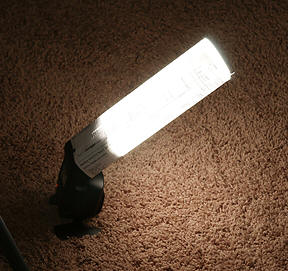
If you're looking for more inspiration for what kind of "Wow!"-type photos can be taken with a couple of wireless flashes and some light modifiers, I strongly encourage you to spend some time at Strobist.com's "On Assignment" archive. They were compiled by a newspaper photographer David Hobby who used wireless flashes to get awesome portraits in the field without a lot of equipment.
The A500's Metering has Nothing to do with Face Detection
In December's newsletter I raved about how unexpectedly good the A500 / A550's metering system was, and at the time I had attributed it to the integration of Face Detection into the metering algorithms. It made perfect sense, and if I were on the design team, I too would have said, "Hey, look, it's reasonable to assume that the face is what you want to focus on, and it's equally reasonable to place a great emphasis on the light on the face when determining what the exposure should be!". Placing such emphasis on the face meant getting great shots in very difficult light - even shots of people who are backlit! (See the December newsletter for examples.)
It turns out that I was completely wrong. I did some follow-up tests with a backlit subject and shot with Face Detection ON and OFF, with Live View ON and OFF, with Multi-segment metering and Center-weighted metering, and even with Autofocus set to ON and OFF. They ALL came out exposed identically to the left figure below. So Face Detection really had nothing to do with it. Then I grabbed my A700 and took the same shot of the same subject. It took a darker shot, as I have been trained to expect from all built-in light meters made since the 1960's.
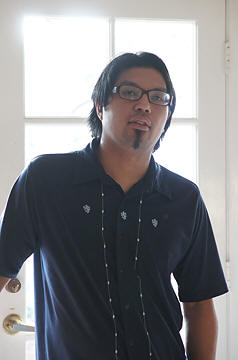
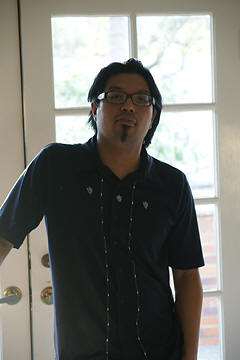
A550 A700
This is both a welcome surprise and a little unsettling. It's welcome because don't we all want the camera to just "make the picture look like what I'm seeing right now?" when we're shooting snapshots, and not have to think like an engineer? It's unsettling because I spent a considerable amount of time in my career understanding how exposure meters worked, knowing under what circumstances they would fail, and what to do about it when they do. This new behavior tosses that knowledge out the window. (Of course it would be worse if I were still shooting slides. At least with Live View you can know right away if your camera's making the right decisions or not, and with Exposure Compensation you can make whatever changes are necessary on the spot.)
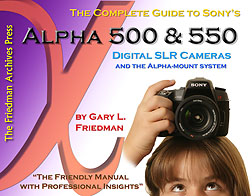 So
what's going on? Here's my best guess: A few key guys from
Sony's camcorder division were loaned to the DSLR division to help
with the metering algorithms. For at least a decade I have
always been impressed at how camcorders from all major brands
handle difficult light much better than your typical DSLR.
And now it seems that that knowledge is starting to creep into our
modern cameras. Is this a good thing? Well, the truth
is that I rarely ever have to invoke Exposure Compensation with the
A550. The other truth is that the new algorithms do a
miserable job of fill-flash on a bright day in AUTO mode (as
documented in the December
Newsletter).
So
what's going on? Here's my best guess: A few key guys from
Sony's camcorder division were loaned to the DSLR division to help
with the metering algorithms. For at least a decade I have
always been impressed at how camcorders from all major brands
handle difficult light much better than your typical DSLR.
And now it seems that that knowledge is starting to creep into our
modern cameras. Is this a good thing? Well, the truth
is that I rarely ever have to invoke Exposure Compensation with the
A550. The other truth is that the new algorithms do a
miserable job of fill-flash on a bright day in AUTO mode (as
documented in the December
Newsletter).
And speaking of the A550, the new book on this camera is out! Click here to learn more. And it, like my other titles, a Spanish version will be available soon.
Seminars
Seminar season is getting busy! We're making travel plans for Copenhagen and Amsterdam in March, and the next one in San Diego, California is in just two weeks! I really enjoy doing the seminars because it allows me to talk more about the joy of taking pictures (and the exploration and personal interaction which goes with it). This is in contrast to the newsletters and the books, which necessarily have to delve into the technical stuff. But I have always believed that the "Wow!"-type picture which everyone wants to take has more to do with light and composition, and less to do with things like whether you're shooting RAW or what color space you're using. These seminars were designed from the ground up to be fun, inspiring, memorable, and to concentrate on the things that are really important to taking great pictures. A lot of things you might have thought were difficult to learn will become intuitive. A well-spent weekend!
The current schedule appears below. And you can learn more the general nature of the seminars here.
| San Diego, CA | February 20-21, 2010 | Sign up! |
| Copenhagen | March 20-21, 2010 | |
| Amsterdam (Technically it's Utrecht) | March 27-28, 2010 | Sign up! |
| Orlando, FL | July 10-11, 2010 | Click here to register interest |
| An outdoor workshop in Yarmouth, Nova Scotia | August 7-9, 2010 | Click here to register interest |
| Truro, Nova Scotia | August 14-15, 2010 | Sign up! |
| Albuquerque, NM | September / October 2010 | Click here to register interest |
The Camera of the Future
Recently one of the Spanish newsgroups had interviewed me (and my very talented Spanish translator, Francesc Garcia) about the books, photography, and other general stuff. (If you're interested you can read the whole thing here, but it's in Spanish. A Google translated version is here.) One of the questions I was asked was "What would your dream camera be like?"
It was a fun question, as it gave me an opportunity to highlight prior cameras which I thought were of a particularly good design (the Konica Minolta 7D with its plethora knobs, rings, and buttons) and designs which I have always wanted to see (the optical viewfinder should be on the BOTTOM of the camera. This way your nose doesn't get in the way or grease up the display on a hot day!).
But then I started to think outside the box a little, and in doing so came up with one of those "Aha!" moments I used to get all the time when I was an engineer and inventor. And at once I started wondering "Why hasn't anyone done this yet?" and "I really want this capability NOW!!" Here's the gist of the idea:
"What I would really like to have is a device which captures not only light and color, but also a spatial representation of the scene. (Kind of like the machines that build 3-D wire frame models of a solid object placed in front of it used in computer animation.) Once you develop an internal 3-D model of the scene you're shooting, you can "re-render it" using CGI techniques with whatever kind of dramatic light you choose later on. Bad light will become a thing of the past! Every image can look like it was shot in a studio with a professional lighting designer."
It seems to me that all the technology is already in place to build such a camera. There are numerous methods of capturing a 3D object and converting it to a wireframe (3D laser scanners, 3D stereoscopic analysis, inferring 3D structures by analyzing visual cues in 2-D images such as shadows, etc.). It should be possible to develop a camera that can capture both 2D (yielding color and texture) and 3D (using any of the above techniques) at the same time. Then, once you have that information, you can use the same tools that Pixar uses to light their wire-frame and textured characters. Professional lighting results without the professional lighting! A more advanced version would have the rendering engine inside the camera - just choose from several formula lighting setups and it creates the .jpg for you automatically.
Remember, you heard this idea here first! I'd patent it but that's a lottery I'm no longer interested in entering. Instead I'm hoping this would inspire someone to develop a system like this and then give it to me for evaluation.
(The other thing I wanted on a future digital camera, "Pulitzer Mode", will have to wait until a future newsletter. :-) )
Until next time...
-Gary Friedman
| Next Newsletter - April, 2010 | |
| Previous Newsletter - December, 2009 | Newsletters Main Page |
Back to the Friedman Archives Home page